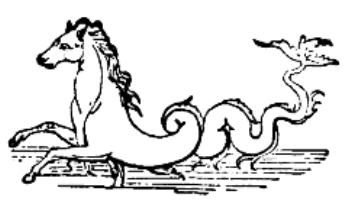Water horse
| Grouping | Cryptid |
|---|---|
| Sub grouping | Lake monster Sea Monster Sea serpent Lake serpent |
| Other name(s) | Kelpie, Waterhorse |
| Country | Scotland Ireland |
| Region | Loch Lough Sea |
| Habitat | Water |
Water Horse is a nickname for the Scottish mythical creature the Kelpie.
Name origin

The term "water horse" (also spelled as "Water Horse" and "Waterhorse") was originally a nickname for the kelpie, a horse like creature similar to the hippocamp that has the head, neck and mane of a normal horse, legs like a horse, webbed feet, and a long, two-lobed, whale-like tail. However, the Water Horse term has also been used as a nickname for lake monsters, particularly Ogopogo and Nessie. The name "kelpie" itself has often been used as a nickname for many other Scottish lake monsters, such as Each uisge and Morag of Loch Morar and Lizzie of Loch Lomond. Other names for these sea monsters include "seahorse" (not referring to the seahorse fish) and "hippocampus" (which is the genus name for everyday seahorses).
The usage of "water horse" or "kelpie" can often be a source of confusion as some take the two terms to be synonymous whist others distinguish the Water Horse as a denizen of lochs while the Kelpie inhabited places of turbulent water such as rivers, fords and waterfalls. A look at the literature does not readily resolve the issue as some authors call one creature of a certain place a kelpie while others call it a water horse. Others will however make the distinction outlined above. However, it is less likely that an inhabitant of rivers will be called a Water Horse which suggests the Kelpie label should be reserved for such places.
The waters are muddied that bit more by some who identify a creature as a Water Bull which others call kelpie or water horse despite the water bull universally being described as less aggressive than the other two.
Physical appearance
In folklore, Water Horses (spelled as "Waterhorse" in folklore) are described as being very similar to a long-necked seal. They are described as having a small head attached to a long giraffe-like neck with an equine mane (occasionally covered in hair) and having two sets of flippers, the rear pair at the very end of the body, giving the impression of a seal-like tail. Its body length ranges from 50–60 feet and the neck is 70 feet long.
Other lake monsters
The Water Horse has often become a basic description of other lake monsters such as the Canadian Lake Okanagan monster Ogopogo and the Lake Champlain monster Champ. The monster Mee-Shee from the 2005 direct-to-video film Mee-Shee: The Water Giant has often been compared to the Water Horse.
In The Water Horse: Legend of the Deep when Angus is looking at reptiles to find out which species Crusoe is, he has a flashback to when his father used to sit in the armchair and tell him stories as to when he grew up on the shores of Loch Morar and how there was rumoured to be "a beastie" living in there, a reference to Morag, the Loch Morar lake monster which has also been portrayed as a Water Horse.
Settings
Whilst most Scottish/Celtic folklore places Water Horses in a loch (particularly a loch that is famous for a lake monster, such as Loch Ness, Loch Morar and Loch Lomond) some tales of Water Horses place them in the ocean, making them sea monsters as well as lake monsters/loch monsters, though the more prominent habitat for a Water Horse is a loch/lake.
Water Horse sightings
Water Horse sightings were reported regularly during the 18th century, but it was not until the 19th century that sightings were starting to get listed:
- In 1846, Captain Christmas of the Danish Navy reported sighting "an enormous, long-necked beast pursuing a school of dolphins" somewhere between Iceland and the Faroe Islands. He described the creature as having a horse-like head and a neck as thick as a man's waist "moving gracefully like a swan's".
- At 5pm on August 6, 1848 an officer of HMS Daedalus noticed as unusual-looking animal swimming towards the ship. It was said to look similar to a sea serpent with a four-foot-long neck. Its head was about 15 or 16 inches long. It was reported to have no visible fins/flippers or tail showing and it had what appeared to be a horsy mane on its neck with seaweed washed over its back.
- In autumn 1883 two horse-headed beasts, one of them smaller than the other (suggesting or implying a juvenile) off the southern coast of Panama. The crew of American whaler Hope On reported seeing a 20-foot-long creature submerge. It was brownish coloured with black speckles and four legs/flippers with a tail "that seemed to be divided into two parts" (implying the whale-like tail appearance) and all four limbs and tail were exposed when it reached the surface. A second creature that looked just like it only much smaller tagged along behind it. In the same year, a sighting of a similar-looking creature occurred in the Bristol Channel. This creature was reported as leaving behind a greasy slug/snail-like trail.
See also
- Champ (cryptozoology)
- Each uisge
- Hippocamp
- Kraken
- Kelpie
- Lake monster
- Leviathan
- Loch Morar
- Loch Ness
- Morag (loch monster)
- Nessie
- Plesiosaur
- Sea monster
- Sea serpent
